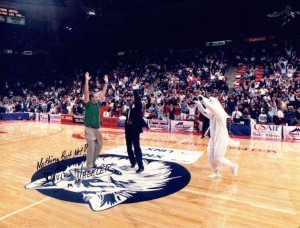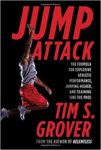Here is the story of “TheShot92” . . . an unabridged edition for your enjoyment!
It happened on . . .
March 4th, 1992
Picture if you will . . .
… a sellout crowd of over 16,000 at the Hartford Civic Center to see the UConn Huskies vs. The Syracuse Orangemen in a Men’s Big East Basketball Game. Like many games late in the basketball season, energy was running high for everyone in attendence.
The first half was exciting and just before both teams head to their locker rooms to strategize at halftime, the UConn sports marketing department, as they always do at UConn games for halftime entertainment, selects 3 contestants for a basketball shooting contest. Contestants are selected by a sticker placed in 3 game programs and the person who makes the most foul shots in 30 seconds wins a chance to shoot for additional prizes.
Tonight, the first two spots are filled by people who had stickers in their programs – but they needed a third person. UConn MBA student Dave Wheeler happens to be near where the contestants are meeting and he happily volunteers when asked to fill the 3rd and last spot. (Sometimes it just helps to be in the right place at the right time).
After the UConn and Syracuse players leave for halftime, the three contestants make their way to the court. Even though the Civic Center seats over 16,000 fans, many are out of their seats during halftime getting refreshments and hitting the rest rooms. The remaining spectators don’t expect much from the shooting contest since it is rare that anyone wins a prize.
Since Dave was selected last, he has to shoot first. His first few foul shots go in easily, then the pressure of the screaming fans sets in … his knees lock up and he misses the next few shots. One voice can be heard distinctly – calling out of the roar of the crowd – “BEND YOUR KNEES” – it sounds exactly like Dave’s Dad . . . even though Dave knows that he’s not there.
Finally Dave makes his last couple shots to end with a score of 6 made baskets in 30 seconds. Dave is disappointed and thinks he could have done better. Compared to other halftime contests that he has seen, he knows that six is really pretty pitiful, but he only has to beat tonight’s competition.
Next to shoot is a middle aged Housewife. She has trouble hitting the backboard at all and doesn’t make a single shot. [Dave lets out a sigh of relief].
Next up is the real competition – an 8 year old boy (with his Dad standing by as a coach). The kid can just barely get the ball to the rim, but one rattles into the net.
He misses a few more, then another falls in. A few more topple in and, as the 30 second buzzer sounds . . . [most impartial observers agree the ball was still in his hands when the buzzer went off] . . . he heaves up one last prayer of a shot . . . it rolls around . . . AND IT GOES IN ! It’s all tied up.
It’s time for a Sudden Death shootout between Dave, a 29 year old graduate student . . . and an eight year old boy.
Dave shoots first and makes his first shot. Dave certainly doesn’t want to be embarrassed by losing to this little kid.
The 8 year old steps up to the foul line, throws it toward the basket and makes his first shot – The crowd goes wild !
Dave steps up for his second shot and the crowd is starting to turn nasty. The want the little kid to win. Did we mention that the contest was right in front of the student section, the rowdiest part of the arena?
It is hard to imagine what it is like to be boo’d by 16,000 people (since, by now, most spectators had returned from getting refreshments or using the bathroom). Even with the crowd against him, Dave makes his second sudden death foul shot and feels pretty confident. The pressure is really on the kid now.
The 8 year old steps to the line, pauses, heaves the ball to the basket – and it hits the front of the rim and bounces up, over, and IN ! [Needless to say the crowd is ecstatic!]
Dave’s third shot. Now he gets to see what visiting players experience when they are shooting foul shots – facing the rowdiest fans in the building – the student section. The BOO’s are raining down from all corners of the arena since everyone wants the 8 year old to win. Dave steps up, shoots, follows through and . . . it goes in.
By now Dave (and the rest of the 16,000 fans) are pretty impressed by this 8 year old. To make two shots in a row is quite an accomplishment – especially against someone who has played basketball all his life and even competed at the college level.
Now the crowd is cheering for the 8 year old to make a third shot – he bounces the ball a couple of times, eyes the rim, takes a deep breath and lets it go. It gets to the rim . . . bounces from side to side . . . and falls out. The crowd moans.
Now Dave gets to shoot for prizes:
Since he won the shootout, he gets to go for the prizes. If the first shot (from the foul line) is made, Dave gets a pair of Reebok sneakers and everyone in the arena gets a free order of bread sticks from Pizza Hut.
The announcer explains the prizes and ends with “good luck Dave”. Strange as it sounds, it is almost like the pressure is off. Dave steps up and makes the free throw.
The second shot is from the Three Point Line – top of the key – about a 20 foot shot. Dave starts to get a little cocky and asks the guy running the event if he should shoot from the College or the NBA 3 point line. He even makes an exaggerated gesture pointing at each line so anyone watching could figure out what he was asking. [Did we mention that Dave was quite the smart aleck ! ? !]
The sports marketing guy running the contest concedes that the college line will be fine, while the announcer is explaining the prizes . . . “If Dave makes this shot he will get a SNET Cellular phone and, instead of bread sticks, everyone in attendance will get a free Personal Pan Pizza from Pizza Hut! Good Luck Dave.”
Upon hearing this the crowd quickly forgets that they were booing him only minutes before and the noise and cheering starts. Dave tracks down the same (good) ball as before and steps up. With a nice easy jump shot, the ball sails toward the basket and splashes through the net. The crowd lets out a huge cheer [since they had just won some pizza]. Now the real tension starts.
The last shot, “theshot92”, is for two round trip tickets anywhere in the Continental U.S. and “Pizza for a Year” for Dave and a medium Pizza Hut pizza for everyone in the Civic Center. Needless to say, all 16,000 fans are on their feet – anyone who had left for intermission has come back in to see what the commotion is all about.
The next shot – from half court – has what seems like an eternity of buildup by the announcer, giving Dave some time to decide how he is going to try to make this shot. He thinks he could throw it, but he wouldn’t have enough control. He could try to shoot it like a regular shot, but probably wouldn’t have enough distance to get it there. Dave decides to shoot it with two hands – kind of like a chest pass.
There is only one over-riding thought – Don’t let it be short. The UConn crowds are notoriously merciless with their chants of “AIR-BALL, AIR-BALL” when opposing teams miss the rim on a foul shot – and that’s when there isn’t even any pizza involved !
Dave figures at the very least by trying to bounce it off the backboard it might compensate for the weakness that has started in his knees and is now spreading to his arms and the rest of my body. The pressure is making Dave “weak in the knees” so adjusts his target and bounces the ball a couple times while he waits.
The announcer wraps up his description of the prizes and gives Dave his cue to shoot, ” . . . Good Luck Dave”.
Dave shoots.
It looks straight.
It’s hard to tell if it will make it . . . until he sees it hit the bottom of the net –
Straight in –
Nothing But Net !
The crowd erupts. The UConn mascot runs over to congratulate him. A standing ovation from 16,000 of his closest friends [remember. . . there was pizza involved].

People from the courtside UConn band ask for Dave’s autograph before he can even leave the court. He must have signed about 20 or 30 programs before finally walking back up to his seat with all the coupons for the prizes. . . shaking hands with everyone as he makes his way up the steps.
Needless to say – the rest of that UConn/Syracuse Big East Basketball game on March 4th, 1992 was kind of anti-climatic. Some people even say they heard a chant near the end of the game “Put in the Pizza Guy” !
That’s the story of TheShot92 !
We hope you enjoyed it.

 The player progression described below** is based on my coaching philosophy and the style of play that I like to use for my teams.
The player progression described below** is based on my coaching philosophy and the style of play that I like to use for my teams.
 The lunge is another underrated drill. In fact,
The lunge is another underrated drill. In fact,  There are 5 key parts to becoming a consistent, successful shooter in the game of basketball. They are simple to understand but only the very best players actually
There are 5 key parts to becoming a consistent, successful shooter in the game of basketball. They are simple to understand but only the very best players actually